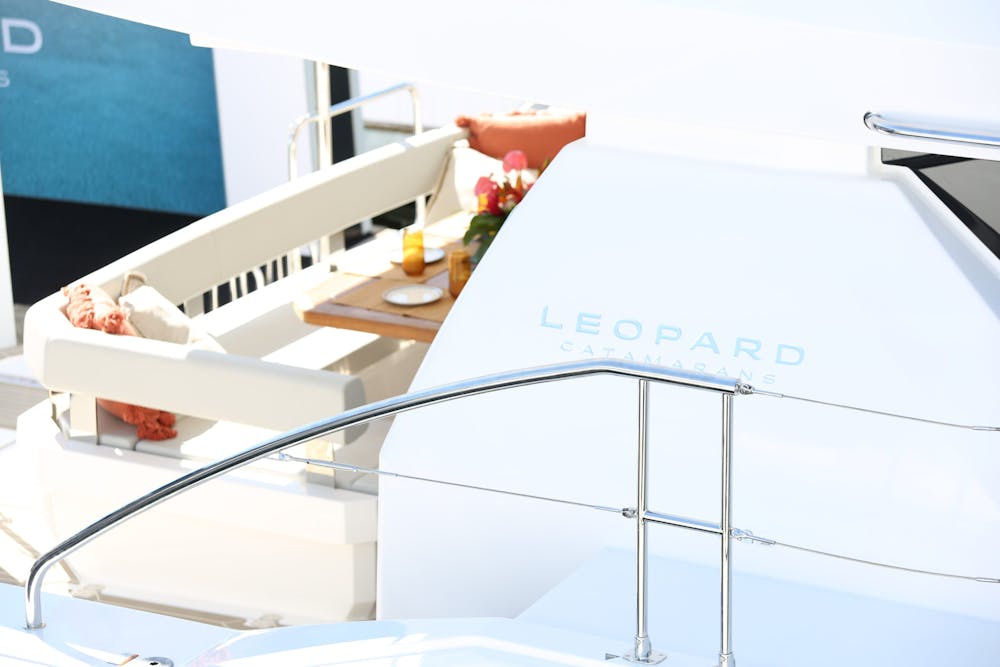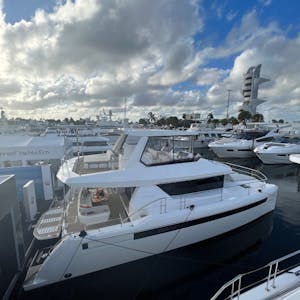Catamarans: Advantages and the Downsides of a double-hulled

What are the advantages and the downsides of a catamaran?
Let’s talk boats – the classic monohull vs. the cool catamaran. Picture this: the monohull’s got one hull, a bit like a lone ranger with a hefty keel. But the catamaran? It’s like the dynamic duo, balancing on two hulls, with sails right in the middle. Easy peasy!
Why do folks go wild for catamarans, you ask? Well, size and stability steal the show. Catamarans boast more room above and below decks, making ’em a hit with vacationers. Plus, with two hulls, they stay as level as a boss, no wild tilts here! It’s a breezier sail, no wrestling with gravity.
Catamarans are the rockstars of the boating world! These double-hulled wonders bring the party to the high seas. Picture this: more space, less rocking, and a smoother ride – it’s like boating in luxury! With their wide stance, they’re as stable as a yoga guru on one foot. Plus, they’ve got speed that’ll make your hair stand on end! And let’s not forget the views – panoramic perfection from every angle. Catamarans are the ultimate waterborne playgrounds, delivering thrills, spills, and chill vibes all in one sleek package. So hop aboard and let the good times roll, because life on a catamaran is a non-stop fiesta!
And get this – they’re not as picky about water depth, so you can explore shallow spots that monohulls can only dream of. At anchor, you won’t be rockin’ and rollin’ all night. Oh, and did we mention the privacy? The two hulls keep things nice and separate. So, when it comes to boats, it’s safe to say, cats have got it all!
But since not everything is all good, below we have created a list of pros and cons of having a catamaran.
ADVANTAGES | Unlocking the Advantages of Catamaran Ownership
Spacious & Stable
Catamarans are very spacious and stable just like a houseboat, so they make great vessels for a vacation or even for those who want to live on a boat. Catamarans are characterized by their dual-hull design, which provides them with several distinct advantages in terms of space and stability.
- Spaciousness: Catamarans generally offer more interior and deck space compared to monohull boats of similar length. This is because the two hulls create a wider platform, allowing for larger cabins, living areas, and deck spaces. This extra room is particularly noticeable in the main living areas like salons, kitchens, and cabins.
- Stability: The wide hulls of a catamaran provide excellent stability on the water. They are less prone to heeling (leaning to one side) compared to monohull boats. This makes catamarans a popular choice for those who may be prone to seasickness or for those who simply prefer a more stable ride.
- Reduced Rolling: Catamarans are less likely to experience the rolling motion that is common on monohull boats. This is because the two hulls work independently, reducing the side-to-side motion that can be uncomfortable for some passengers.
- Shallow Draft: Catamarans often have a shallower draft compared to monohulls of similar size. This allows them to access shallower anchorages and coastal areas that may be off-limits to deeper-draft boats.
- Privacy: The dual-hull design of catamarans often allows for more private sleeping arrangements. Cabins are typically located in separate hulls, providing more individual space and privacy for guests.
- Entertaining Space: The wide deck area between the hulls, known as the trampoline, offers a fantastic space for socializing, sunbathing, or enjoying the scenery. It’s a unique feature that many catamaran enthusiasts appreciate.
Safety
Safety! Catamarans are safe for cruising and even safe for those adventurous people who want to cross the ocean. In fact, catamarans are often much safer than similarly sized yachts. Safety comes from increased motion comfort, great stability, speed, and excess buoyancy due to lack of ballast. Catamarans are good even in rough water.
- Escape Routes: Catamarans typically have multiple exit points, allowing for quicker and easier evacuation in case of an emergency.
- Redundancy: With two engines, two rudders, and often two separate electrical systems, catamarans have built-in redundancy. If one engine or system encounters a problem, the other can usually compensate.
- Bouyancy: In the event of hull damage, catamarans tend to stay afloat due to the inherent buoyancy of their multiple hulls. This provides more time for passengers and crew to take necessary safety measures.
- Visibility: The elevated helm positions on many catamarans provide excellent visibility for the captain, allowing them to see potential hazards or other vessels more easily.
Inside and outside steer
Many catamarans are designed with both inside and outside steering options. This provides flexibility for the captain to choose the most suitable steering position depending on weather conditions, visibility, and personal preference. So, captains have the option to steer from the inside during bad weather or when the water conditions are less than ideal. Keep in mind that the specific configuration may vary depending on the make and model of the catamaran
- Inside Steering: Catamarans typically have an inside helm station located in the main salon or cabin. This allows the captain to steer and navigate the boat from the comfort of an enclosed space, protected from the elements. Inside steering is particularly advantageous in adverse weather conditions or when additional shelter is needed.
- Outside Steering: Catamarans also have an outside helm station usually located on the deck, often near the aft (rear) of the boat. This provides a more open and unobstructed view of the surroundings, which can be beneficial for maneuvering in tight spaces, close-quarters situations, or when the weather is favorable.
Withstand high winds
If you are worried about windy weather, catamarans are also known for their excellent ability to withstand high winds. Catamarans are generally designed to withstand high winds quite well due to their inherent stability and aerodynamic profile. While catamarans are designed to handle high winds, it’s important for any boat, including catamarans, to be operated with caution in extreme weather conditions. The experience and skill of the captain, as well as adhering to proper safety protocols, are crucial for ensuring a safe boating experience in challenging weather. Additionally, all boats should be equipped with appropriate safety gear, including life jackets, navigation lights, and communication devices.
Here are a few reasons why catamarans are well-suited for handling high winds:
- Wide Beam: Catamarans have a wide beam (the distance between the two hulls), which provides a stable platform. This wide stance helps distribute the forces of the wind, reducing the likelihood of capsizing or heeling over.
- Low Center of Gravity: The weight of a catamaran is distributed lower in the water compared to a monohull boat. This low center of gravity contributes to stability in strong winds.
- Reduced Heeling: Catamarans are less prone to heeling (leaning to one side) compared to monohull boats. This means they maintain a more level position in high winds, providing a more comfortable and secure ride for passengers.
- Aerodynamic Design: Catamarans have a sleek and aerodynamic profile, which allows them to slice through the wind more efficiently than some other types of boats. This helps reduce the resistance to strong winds.
- Structural Integrity: Well-built catamarans are constructed with strong and durable materials. This ensures that they can handle the stresses and pressures associated with high winds.
Buoyancy
Catamarans rely on the buoyancy of their two hulls as opposed to yachts, that only have a single hull. They can be in shallower water without losing stability or the ability to navigate. Yachts rely on a deeper draft to ensure the performance of the boat.
Fuel
Less fuel? Yes, catamarans have less resistance to get on plane, which results in fuel economy. Their speed rises steadily and there is little to no spikes in fuel consumption. Catamarans are generally more fuel-efficient than similar-sized monohull boats due to their design characteristics. Here are some reasons why catamarans tend to be more fuel-efficient:
- Reduced Drag: The hull design of a catamaran creates less water resistance compared to a monohull. This means that it requires less power to achieve and maintain a given speed, resulting in lower fuel consumption.
- Lighter Weight: Catamarans are often lighter than monohulls of similar size. This means they require less power to move through the water, which in turn leads to improved fuel efficiency.
- Multiple Engines: Many catamarans are equipped with twin engines, which allows for better maneuverability and fuel efficiency. The ability to operate on a single engine at lower speeds can save fuel compared to running a larger single engine at higher speeds.
- Sail Option: Some catamarans are designed with sails in addition to engines. When conditions allow, using sails can significantly reduce fuel consumption, as the wind provides propulsion.
- Diesel-Electric Hybrid Systems: Some modern catamarans are equipped with advanced propulsion systems, including diesel-electric hybrids. These systems can optimize fuel consumption by efficiently managing power sources.
- Shallower Draft: Catamarans often have a shallower draft compared to monohulls, which allows them to access more fuel-efficient routes, such as shallower anchorages and coastal areas.
DISADVANTAGES | The Drawbacks of Catamaran Ownership
Stability for some is a no go!
For those that are into sailing sports, Catamaran yachts are not the most suitable. Why? Well, for the same reasons that make them great houseboats, stability. For that reason, half of the yachtsmen would never buy them. If there is too much sail exposed to the wind and the force of the wind is greater than the weight of the boat … wow… there it goes. The boat will literally trip sideways over the downwind side hull, capsizing. This can happen to small and large cats alike.
- Performance in Light Winds: Catamarans, especially those with a wider beam, may not perform as well in very light winds compared to monohulls. The reduced heeling and narrow hulls of monohulls can sometimes give them an edge in extremely light conditions.
- Difficulty in Heeling for Sailing Enthusiasts: Sailing purists who enjoy the challenge of heeling and working with the natural forces of the wind may find catamarans less engaging, as they tend to remain level even under sail.
Marina
The cost of keeping a catamaran in a marina can vary widely depending on factors such as location, marina facilities, boat size, and amenities offered. Marina fees are often based on the length of the boat. Catamarans, which tend to be wider than monohulls of similar length, may be charged a higher fee to accommodate their beam. Some yacht clubs may not even be suitable for catamarans.
Docking and Close Quarters Maneuvering
Docking a catamaran can present different challenges compared to docking a monohull due to its wider beam and dual-hull configuration. Catamarans often have twin engines and two separate hulls, which can make tight maneuvering in marinas or docking in narrow spaces a bit more challenging compared to monohulls.
- Width: Catamarans are typically wider than monohull boats of similar length. This can make it more challenging to navigate tight spaces in marinas or docking areas.
- Windage: Catamarans have a larger surface area exposed to the wind, which can make them more susceptible to being pushed off course during docking. Captains need to be aware of wind direction and strength when maneuvering a catamaran.
- Propeller Configuration: Catamarans often have twin engines, which can provide more precise control during docking. However, it also means the captain needs to be skilled at maneuvering with dual propulsion.
- Depth Perception: The separation of the hulls can make it harder to judge distances and angles when approaching a dock or slip. Captains may need to rely on experience and practice to develop a good sense of depth perception.
- Visibility: The position of the helm station on a catamaran can vary, but it’s typically higher and more centralized compared to monohulls. This can provide better visibility, but it may still take some adjustment for captains who are used to the lower vantage point of monohull boats.
- Tight Quarters: Maneuvering a catamaran in a crowded marina or in narrow waterways can be more challenging due to its width. Captains may need to plan their approach carefully and consider factors like current, wind, and other vessels.
Service
The services can also be more expensive. Remember, there are two engines instead of just one. The cost of servicing a catamaran can vary depending on factors such as the specific make and model, age, size, and the complexity of its systems. In general, there are a few considerations that may affect the overall cost of servicing a catamaran:
- Twin Engines: Many catamarans have twin engines, which means there are two engines to maintain and service. This can potentially increase the cost of engine maintenance compared to a monohull with a single engine.
- Additional Systems: Catamarans may have additional systems and equipment, such as two steering systems, two electrical systems, and more plumbing. This can lead to potentially higher maintenance costs compared to monohulls.
- Specialized Knowledge: Some maintenance tasks for catamarans require specialized knowledge or expertise due to their unique design. This may result in higher labor costs or the need to hire technicians with specific catamaran experience.
- Sail Handling: If the catamaran is equipped with sails, maintaining and servicing the rigging, sails, and associated equipment may add to the overall cost.
- Anti-Fouling and Bottom Paint: Due to their wider beam, catamarans often have more hull surface area to cover with anti-fouling paint. This can lead to higher material costs for bottom maintenance.
- Insurance and Documentation: Insurance premiums for catamarans may be higher due to their higher value and unique characteristics. Additionally, documentation and registration fees may vary depending on the type of vessel.

It’s important to note that these potential drawbacks are subjective and may not be significant concerns for all sailors or boat owners. Ultimately, the choice between a catamaran and a monohull should be based on individual preferences, priorities, and the intended use of the vessel.


